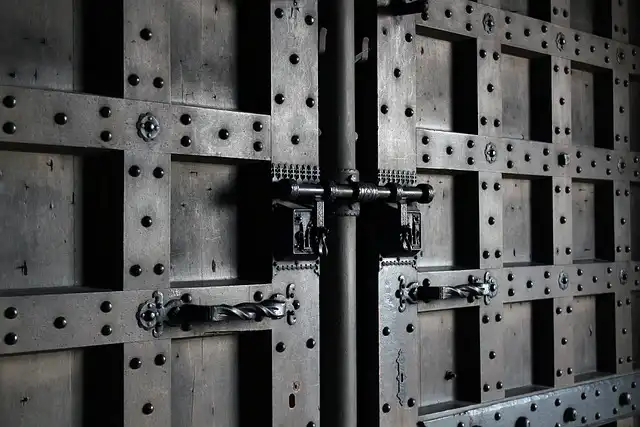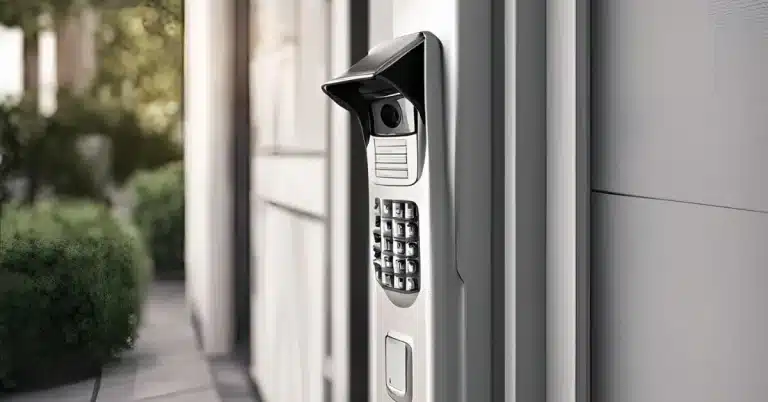You’ve probably locked your doors, set up an alarm, and maybe even installed a security camera or two. But do you feel completely safe in your home? Here’s the truth: relying solely on physical security measures may leave your home vulnerable. While gates, locks, and cameras are essential, they’re only part of the equation.
So, what’s not a physical security measure for your home? It’s crucial to understand the non-physical strategies that complement your physical measures to create a truly secure environment. In this guide, we’ll explore the often-overlooked components of home security and why they matter just as much (if not more) than your fence or alarm system.
1. Physical Security Measures: Are They Enough?
When we think of home security, the first things that come to mind are usually locks, alarms, gates, and fences. These physical barriers serve as the first line of defense against burglars or intruders. But how effective are they really?

What Physical Security Measures Do for You:
- Locks and Alarms:
These are the basic yet fundamental tools of home security. A solid lock on your door and a loud alarm can prevent many burglars from entering your home. - Gates and Fences:
A tall, sturdy fence can act as a deterrent, making it harder for burglars to gain access to your property. Gates with locks can further enhance this. - Security Cameras:
Video surveillance systems are great for monitoring suspicious activity, especially when combined with motion sensors or smart home devices.
However, physical measures alone often fail to prevent break-ins or other security breaches. According to recent studies, many burglars target homes with visible physical security measures, knowing they can be bypassed with the right tools or strategies.
When Physical Security Falls Short:
While physical measures reduce the chances of a break-in, criminals are becoming more sophisticated. Locks can be picked, alarms can be disabled, and fences can be climbed. In fact, many burglars choose homes based on ease of access — a good fence or security camera is useless if they can bypass it in a few minutes. To strengthen your security, it’s essential to combine these physical measures with other strategies. For more tips on improving your home security, check out the National Crime Prevention Council’s home security tips.
2. Non-Physical Security Measures: The Often-Overlooked Elements
Now that we’ve acknowledged the limitations of physical security, let’s dive into the critical non-physical security measures that can make all the difference. What is not a physical security measure for your home? The answer is simple: things like community involvement, cybersecurity, and surveillance systems all play major roles in your overall home security.
What Are Non-Physical Security Measures?
Non-physical measures refer to the strategies and tools that don’t involve physical barriers but contribute immensely to the security of your home. These include things like:
- Surveillance Systems
- Community Engagement
- Cybersecurity Awareness
- Public Engagement & Alerts
Let’s take a closer look at each of these.
3. Surveillance Systems: More Than Just Cameras
When we think of home surveillance, the first thing that probably comes to mind is cameras. But today’s surveillance systems have advanced far beyond simple video recording. Smart home technology now offers full-service solutions that integrate surveillance with real-time alerts, motion sensors, and even remote monitoring.

Beyond Just Cameras:
- Smart Surveillance:
Smart security systems can notify you on your phone when there’s suspicious activity in or around your home. They can even differentiate between humans and animals, giving you alerts that matter. - 24/7 Monitoring:
Modern systems don’t just record footage — they monitor continuously, providing live updates to you and sometimes to a professional security team. If an alarm goes off, the monitoring center can instantly alert authorities. - Advanced Sensors:
Along with cameras, advanced motion sensors, glass break sensors, and door/window open detectors can be set up to monitor activity and reduce false alarms.
By investing in a smart surveillance system, you gain a higher level of security, ensuring that even if someone bypasses your physical measures, you’ll be alerted before any damage is done.
4. Community Engagement: The Power of Neighborhood Watch
Let’s be honest — most of us don’t live in isolated homes. Our safety is directly tied to the safety of our neighborhoods. This is where community engagement becomes crucial.

How Neighborhood Watch Programs Help:
- Collective Vigilance:
Having a neighborhood watch in place creates an atmosphere of collective responsibility. If everyone is aware of what’s going on around them, it becomes harder for criminals to operate unnoticed. - Shared Resources:
Community programs often have the resources to install neighborhood-wide surveillance systems, and there’s strength in numbers when it comes to reporting suspicious activity. - Emergency Alerts and Group Chats:
Many neighborhoods now use apps or group chats to communicate quickly about security issues, such as a new threat or suspicious behavior in the area.
A connected community can discourage criminal activity. The presence of concerned neighbors who are watching out for each other makes it much harder for burglars to target your home. If you’re interested in learning more about building a neighborhood watch, visit the National Neighborhood Watch Program.
5. Cybersecurity: Don’t Let Digital Break-Ins Undermine Your Physical Security
Home security isn’t just about fences and locks anymore; it’s also about safeguarding your digital life. Cybersecurity breaches, such as hacking into your home’s smart devices, can compromise your physical security.

The Link Between Cybersecurity and Physical Security:
- Smart Home Devices:
From smart locks to security cameras, these devices can make your life more convenient, but they also open the door for hackers. A cybercriminal could potentially hack into your security system and deactivate it remotely. - Wi-Fi Networks:
Most smart home devices are connected to your Wi-Fi network. If someone can breach your network, they can gain access to your entire security setup. - Personal Data Protection:
Don’t forget about securing your online accounts. If your personal data is compromised, hackers can potentially use it to target you physically or financially.
To better understand how to protect your smart devices, we recommend reading these cybersecurity tips for your smart home to help safeguard your digital infrastructure.
What You Can Do:
- Regularly update your device’s software to patch vulnerabilities.
- Use strong, unique passwords for all your devices and Wi-Fi.
- Implement two-factor authentication where possible.
By protecting your digital assets, you strengthen the overall security of your home.
6. Professional Security Services: Why They Shouldn’t Be Overlooked
You might think of security services as an unnecessary expense, but the truth is that professional security companies bring an extra layer of protection that goes beyond DIY solutions.
What Professional Security Services Offer:
- Tailored Security Plans:
Professionals assess your home and develop a personalized security strategy that fits your unique needs, including both physical and non-physical measures. - Response Teams:
In case of a break-in, having a professional security team on standby can make a huge difference in ensuring that the intruder is apprehended quickly. - Expertise in Risk Management:
Professionals bring knowledge of the latest trends in security technology, ensuring that your home is always protected with the most advanced tools and strategies.
By investing in a professional security service, you’re taking proactive steps to secure your home and your family.
7. Nuisance Mitigation: Simple Fixes That Make a Big Difference
Sometimes, simple maintenance can play a huge role in improving the security of your home. Overgrown shrubs, poorly-lit entryways, and unkempt lawns can all make it easier for criminals to hide and move undetected.
Key Areas to Focus On:
- Lighting:
A well-lit home is a deterrent to criminals. Make sure to install motion-activated lights around your property to eliminate dark spots that could be used for hiding. - Maintenance:
Trim bushes and trees near windows and doors. If criminals can hide behind them, they can easily break into your home without being seen. - Clear Pathways:
Keep entryways and paths clear to make sure intruders have nowhere to hide. Also, ensure gates and fences are well-maintained.
Even these small actions contribute to creating a safer home environment.
8. FAQs: Common Misconceptions About Home Security
Q1: Can a high fence alone ensure my home is safe?
While a high fence helps, it doesn’t cover all security angles. Combining it with smart surveillance, lighting, and community engagement enhances overall safety.
Q2: Is professional security really needed for a typical homeowner?
Yes! Professional services offer tailored solutions that extend beyond the capabilities of DIY setups. They provide expert monitoring and ensure you’re covered even in the most vulnerable spots.
Conclusion:
Securing your home is not just about locking your doors and setting up alarms. As we’ve discussed, a holistic approach to security includes both physical and non-physical measures that work together to create a comprehensive defense system.
So, what is not a physical security measure for your home? It’s everything that complements your tangible security — things like smart surveillance, community involvement, and cybersecurity awareness.
By integrating both physical and non-physical strategies, you can ensure your home remains safe, secure, and well-protected from a wide range of threats.
Ready to step up your home security? Start by assessing your current systems and make sure you’re not missing any crucial non-physical measures. Your home’s safety is worth the effort!
Looking to level up your home security? Don’t miss our expert guides on the best home security camera features, top indoor motion detection systems, and unbeatable DIY surveillance solutions — At EvoAbode, we help you make your home safer!


This Post Has 7 Comments
Pingback: sildenafil 50 mg tablet
vardenafil 10mg pills levitra headache prevention levitra special instructions
Thanks for the sensible critique. Me & my neighbor were just preparing to do a little research on this. We got a grab a book from our area library but I think I learned more from this post. I am very glad to see such wonderful info being shared freely out there.
What i do not understood is if truth be told how you’re not really a lot more neatly-liked than you might be now. You are so intelligent. You realize therefore considerably in terms of this subject, produced me in my opinion consider it from so many varied angles. Its like women and men are not involved unless it¦s one thing to do with Girl gaga! Your own stuffs outstanding. All the time take care of it up!
Giao diện đẹp và dễ sử dụng là một trong những ưu điểm nổi bật của 188v. Với màu trắng và xanh biển tươi mát làm màu chủ đạo, làm cho giao diện của trang web rất dễ chịu và không nhàm chán.
Giao diện đẹp và dễ sử dụng là một trong những ưu điểm nổi bật của 188v. Với màu trắng và xanh biển tươi mát làm màu chủ đạo, làm cho giao diện của trang web rất dễ chịu và không nhàm chán.
Giao diện đẹp và dễ sử dụng là một trong những ưu điểm nổi bật của 188v. Với màu trắng và xanh biển tươi mát làm màu chủ đạo, làm cho giao diện của trang web rất dễ chịu và không nhàm chán.